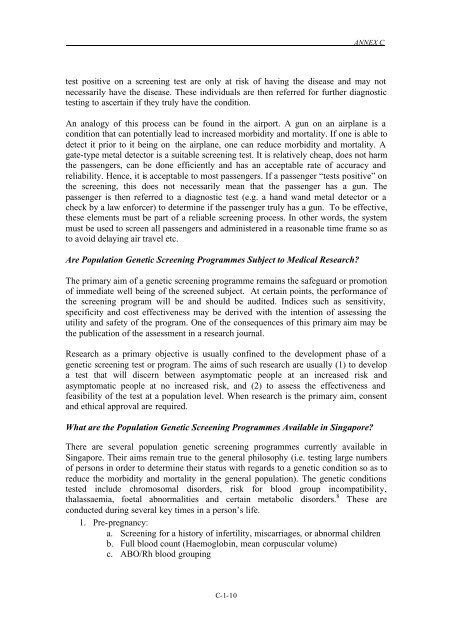Medical, ethical, legal and social issues in genetic - Bioethics ...
Medical, ethical, legal and social issues in genetic - Bioethics ...
Medical, ethical, legal and social issues in genetic - Bioethics ...
You also want an ePaper? Increase the reach of your titles
YUMPU automatically turns print PDFs into web optimized ePapers that Google loves.
C-1-10<br />
ANNEX C<br />
test positive on a screen<strong>in</strong>g test are only at risk of hav<strong>in</strong>g the disease <strong>and</strong> may not<br />
necessarily have the disease. These <strong>in</strong>dividuals are then referred for further diagnostic<br />
test<strong>in</strong>g to ascerta<strong>in</strong> if they truly have the condition.<br />
An analogy of this process can be found <strong>in</strong> the airport. A gun on an airplane is a<br />
condition that can potentially lead to <strong>in</strong>creased morbidity <strong>and</strong> mortality. If one is able to<br />
detect it prior to it be<strong>in</strong>g on the airplane, one can reduce morbidity <strong>and</strong> mortality. A<br />
gate-type metal detector is a suitable screen<strong>in</strong>g test. It is relatively cheap, does not harm<br />
the passengers, can be done efficiently <strong>and</strong> has an acceptable rate of accuracy <strong>and</strong><br />
reliability. Hence, it is acceptable to most passengers. If a passenger “tests positive” on<br />
the screen<strong>in</strong>g, this does not necessarily mean that the passenger has a gun. The<br />
passenger is then referred to a diagnostic test (e.g. a h<strong>and</strong> w<strong>and</strong> metal detector or a<br />
check by a law enforcer) to determ<strong>in</strong>e if the passenger truly has a gun. To be effective,<br />
these elements must be part of a reliable screen<strong>in</strong>g process. In other words, the system<br />
must be used to screen all passengers <strong>and</strong> adm<strong>in</strong>istered <strong>in</strong> a reasonable time frame so as<br />
to avoid delay<strong>in</strong>g air travel etc.<br />
Are Population Genetic Screen<strong>in</strong>g Programmes Subject to <strong>Medical</strong> Research?<br />
The primary aim of a <strong>genetic</strong> screen<strong>in</strong>g programme rema<strong>in</strong>s the safeguard or promotion<br />
of immediate well be<strong>in</strong>g of the screened subject. At certa<strong>in</strong> po<strong>in</strong>ts, the performance of<br />
the screen<strong>in</strong>g program will be <strong>and</strong> should be audited. Indices such as sensitivity,<br />
specificity <strong>and</strong> cost effectiveness may be derived with the <strong>in</strong>tention of assess<strong>in</strong>g the<br />
utility <strong>and</strong> safety of the program. One of the consequences of this primary aim may be<br />
the publication of the assessment <strong>in</strong> a research journal.<br />
Research as a primary objective is usually conf<strong>in</strong>ed to the development phase of a<br />
<strong>genetic</strong> screen<strong>in</strong>g test or program. The aims of such research are usually (1) to develop<br />
a test that will discern between asymptomatic people at an <strong>in</strong>creased risk <strong>and</strong><br />
asymptomatic people at no <strong>in</strong>creased risk, <strong>and</strong> (2) to assess the effectiveness <strong>and</strong><br />
feasibility of the test at a population level. When research is the primary aim, consent<br />
<strong>and</strong> <strong>ethical</strong> approval are required.<br />
What are the Population Genetic Screen<strong>in</strong>g Programmes Available <strong>in</strong> S<strong>in</strong>gapore?<br />
There are several population <strong>genetic</strong> screen<strong>in</strong>g programmes currently available <strong>in</strong><br />
S<strong>in</strong>gapore. Their aims rema<strong>in</strong> true to the general philosophy (i.e. test<strong>in</strong>g large numbers<br />
of persons <strong>in</strong> order to determ<strong>in</strong>e their status with regards to a <strong>genetic</strong> condition so as to<br />
reduce the morbidity <strong>and</strong> mortality <strong>in</strong> the general population). The <strong>genetic</strong> conditions<br />
tested <strong>in</strong>clude chromosomal disorders, risk for blood group <strong>in</strong>compatibility,<br />
thalassaemia, foetal abnormalities <strong>and</strong> certa<strong>in</strong> metabolic disorders. 8 These are<br />
conducted dur<strong>in</strong>g several key times <strong>in</strong> a person’s life.<br />
1. Pre-pregnancy:<br />
a. Screen<strong>in</strong>g for a history of <strong>in</strong>fertility, miscarriages, or abnormal children<br />
b. Full blood count (Haemoglob<strong>in</strong>, mean corpuscular volume)<br />
c. ABO/Rh blood group<strong>in</strong>g


